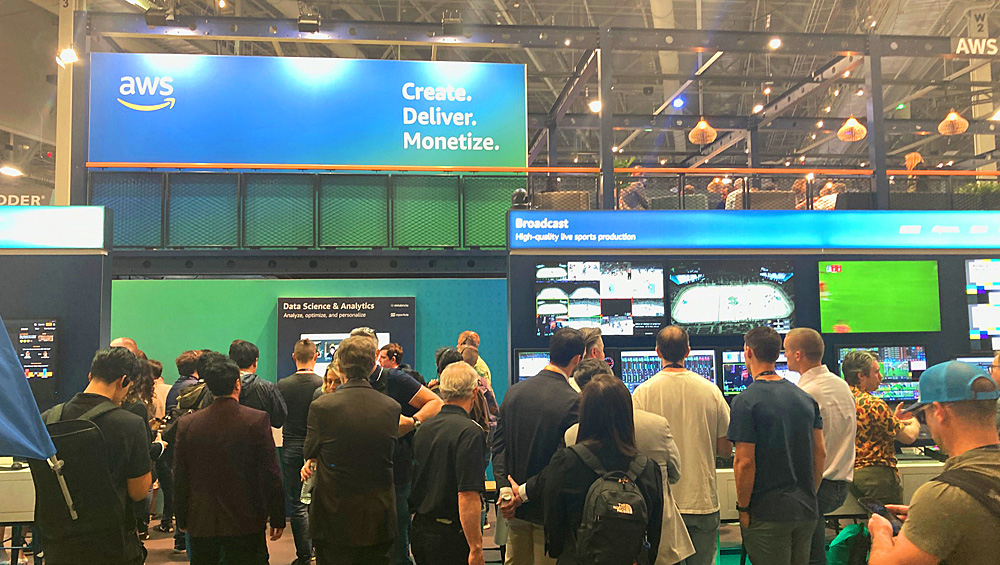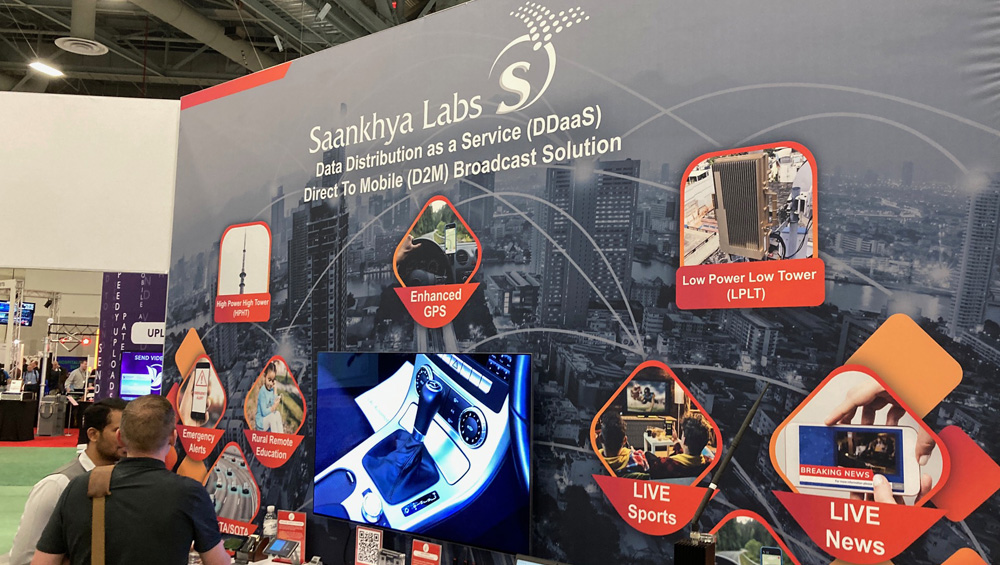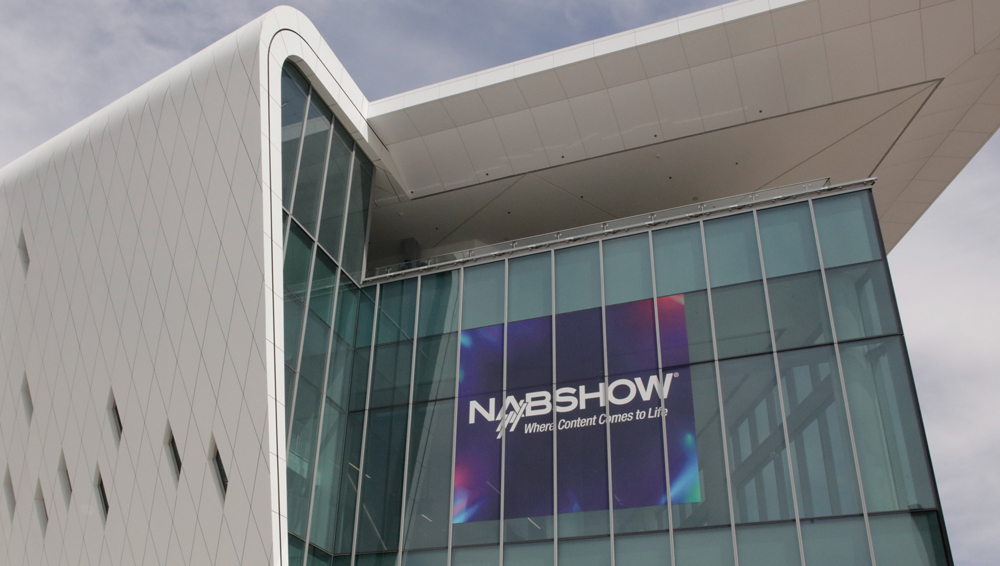
Fuller Halls, Strategic Partnerships Mark Resurgent NAB Show In Las Vegas

LAS VEGAS — In its second edition after a two-year hiatus due to the COVID-19 pandemic, the annual NAB Show held in Las Vegas this week demonstrated that the traditional technology trade show model continues to rebound. NAB 2023 posted solid growth over 2022 in both total exhibitors and attendees, and the exhibit halls were busier though still much less congested than in pre-pandemic days.
NAB’s preliminary numbers indicated that 65,013 attendees made the trip, roughly a 24% increase over the 52,468 in 2022. 1,208 companies exhibited, a 28% jump over the 940 last year. NAB organizers had projected that international attendance would be much stronger this year, given the lifting of vaccine requirements and travel restrictions, and that proved true. There were 17,446 international attendees and 166 countries represented, compared to 11,542 and 155 last year.
While overall attendance still paled in comparison to the 91,921 attendees in 2019, vendors reported strong traffic in their booths. Jeff Moore, EVP and CMO for Ross Video, said the company’s large North Hall booth filled up 30 minutes after the floor opened on Sunday morning and stayed busy all day. But Ross Video will be moving its booth next year, as NAB reconfigures the overall exhibition in 2024 and 2025 to again include the South Hall while the North Hall is closed for renovations.
Ross is returning to South, where it had exhibited for many years through NAB 2019, and that is fine by Moore. “We know it,” he said.
Changes In West Hall
Other vendors expressed some concern with the new layout, particularly given the considerable distance between South and the LVCC’s new West Hall. That space made its NAB debut in 2022 and was reconfigured by show organizers this year to serve as a “broadcast hub.” Radio and transmission vendors were consolidated there, and most conference sessions and panel presentation relevant to station and network executives were either held in “content theaters” on the floor or in the meeting rooms upstairs.
West Hall was also home to a large booth secured by the Advanced Television Systems Committee (ATSC) in which multiple companies demonstrated various applications for the new ATSC 3.0 broadcast standard, including SDR to HDR conversion in local broadcasts and the delivery of interactive broadcast apps to NextGen TV sets.

One of the 3.0 applications being demonstrated in the ATSC booth was “Data Distribution as a Service” to 3.0 devices including mobile phones, which Sinclair has been developing in partnership with Indian chip manufacturer Saankhya Labs.
The changes had a positive effect, as the far end of this cavernous new exhibition hall was certainly busier than last year, and West seemed to have more traffic overall than the Central or North Halls. But much of the buzz at West could also be attributed to the big cloud companies such as Amazon Web Services (AWS) and Microsoft that exhibited there, as broadcasters continue to shift from specialized on-premise hardware to flexible software applications running on generic computing power, whether in the public cloud or their own data centers.
One of the companies enjoying the cloud effect in West was IP monitoring supplier TAG Video Systems. TAG chief strategy and cloud officer Peter Wharton said the booth was “very busy,” and that his schedule was jam-packed with appointments each day of the show.
“There’s nothing I’ve heard or saw this week that made me think a recession is around the corner,” Wharton said.
Also located in West was Imagine Communications, in a smaller booth than it occupied in Central Hall last year. Imagine president Steve Reynolds said he was “glad we made the jump,” as it put Imagine near the cloud companies with which it has been working.
Strategic Partnerships
One of those rapidly growing cloud companies is Amagi, with whom Imagine announced a strategic partnership at the show. Imagine will now resell Amagi’s Cloudport playout software, integrating it with the Aviator “orchestration console” it launched last year, while Amagi will integrate Imagine’s SureFire video ad server, which provides “broadcast-grade” ad decisioning, into its Thunderstorm digital ad insertion product.
For an NAB light on news in terms of major customer deals or mergers and acquisitions between vendors, Imagine’s deal with Amagi was significant in that it showed the shifting fortunes of traditional broadcast vendors like Imagine, which had previously been competing in cloud playout with Aviator, versus cloud-native companies like Amagi, which has been dominating the booming FAST channel market with its cloud playout software. Amagi is also moving into linear cloud playout, announcing a deal with Sinclair Broadcast Group to move playout of all of Sinclair’s local stations to the AWS cloud by 2025.
When Imagine executives first met with Amagi a few months ago, Reynolds went into the conversation with the view that the two companies were direct competitors. But he said the “more time we spent with them, the more we came to realize that we are more complementary than competitive.”
The new Imagine/Amagi solution allows a customer who wants to run a hybrid cloud/ground model to use on-premise Imagine Versio hardware servers in combination with native cloud playout via Amagi, such as for FAST or disaster-recovery channels. Aviator Orchestrator will provide control over the hybrid cloud and ground topology, and SureFire will provide broadcast ad decision-making functions for spots that will then be delivered by Amagi’s Thunderstorm platform.
“From here on out we’ll just sell Cloudport engines,” Reynolds said. “There’s too much reinvention of the wheel that goes on in this industry. What we’ve decided to do is to stop building things that other people have already built. If there is something we need, we would rather partner with somebody, because that allows us to accelerate time to market, and for the customer to accelerate their time to revenue. People don’t have time to wait around for us to invent things that have already been invented.”
 At NAB, Amagi unveiled another deal with a legacy broadcast supplier in the form of a strategic partnership with Encompass Digital Media, which station groups and cable networks have long used as an outsourcing solution for hubbed master-control playout and other managed services. Under the deal Encompass has selected Amagi as a technical partner for cloud-based FAST and playout solutions, essentially outsourcing some of the outsourcing business it had previously done on-premise.
At NAB, Amagi unveiled another deal with a legacy broadcast supplier in the form of a strategic partnership with Encompass Digital Media, which station groups and cable networks have long used as an outsourcing solution for hubbed master-control playout and other managed services. Under the deal Encompass has selected Amagi as a technical partner for cloud-based FAST and playout solutions, essentially outsourcing some of the outsourcing business it had previously done on-premise.
Marco Di Giacomo, chief marketing officer for Amagi, explained that the Encompass deal with Amagi addressed the gradual evolution in the industry from broadcasters first consolidating and managing their data centers, to outsourcing the management of the data center to a third party, to eventually running those data center functions in the public cloud.
“The idea is that customers have the need to feel that one, they have full control over when and how and what to shift to cloud, and two, the opportunity to mix workloads across on-premise and the cloud,” Di Giacomo said. “And so, with the partnership with Encompass, essentially what we give them access to is the managed service provider business that Encompass has so that they can provide professional services for the migration.”
It also gets Amagi out of providing managed services itself, which it has been providing to some early customers based on their requests but doesn’t see as being core to its long-term business. Going forward, Amagi will point customers looking for managed services to Encompass.
“The realization was that there were multiple customers that were expecting to be able to go all the way to cloud, and therefore Encompass recognized that there were customers they had an opportunity to monetize by partnering with us,” Di Giacomo said. “And vice versa, we always had customers who were using our managed services, which weren’t necessarily core to our solution.
“It was something we were doing because customers were asking for it, but again, we’re a cloud company not a data center management company, and we don’t want to be one,” he continued. “So, it was kind of a, ‘You give me yours, I give you mine’ situation.”
Cloud Developments
Another traditional vendor with cloud news at NAB was Grass Valley, which has invested over $200 million so far in its Advanced Media Processing Platform (AMPP) cloud software, CEO Louis Hernandez Jr. told the audience at the Devoncroft conference on Saturday. AMPP is providing the technical backbone for CBS Sports’ new soccer network, Golazo Network, handling all playout, recording, routing and switching functions from the AWS cloud.
Grass Valley has drawn criticism from some broadcast customers and other industry players over the past year for focusing on AMPP at the expense of its traditional hardware products like cameras and switchers, which are widely used in live production. Hernandez said while that the industry’s future certainly lies in the cloud, Grass Valley is not giving up on its hardware business, and he pointed to new hardware products launched at NAB including the LDX C135 compact IP-native camera. But he did say that the company may outsource the manufacturing of some of its hardware products in the future.
“We have upgrades across the portfolio,” Hernandez said. “We have no intention of getting out of any hardware category, in fact you’ll see an expansion. But it doesn’t mean that we’ll be doing all of the manufacturing ourselves. There will branded Grass Valley products, and we will continue to support them as long as our clients want us to.”
































Comments (0)